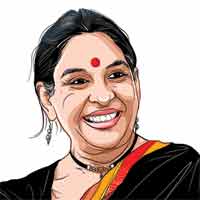Opinion Taxing the artisan
The voice of craftspeople must not be silenced in the transition to GST
 Union minister Pon Radhakrishnan said wrong information should not be spread through cinema and actors should not confuse people using the medium and try to derive political mileage.
Union minister Pon Radhakrishnan said wrong information should not be spread through cinema and actors should not confuse people using the medium and try to derive political mileage.  The cess on luxury cars has been hiked to 25 percent from 15 per cent.
The cess on luxury cars has been hiked to 25 percent from 15 per cent.
The GST works fairly painlessly in the few countries that have introduced this taxation system. They have few slabs and easy procedures, largely because they are developed, industrialised and less populated than India, which has had to go about this tax regime in a cumbersome manner.
In the GST process, the cottage and tiny sector, which has a workforce of 110 lakh, has remained voiceless. This number is actually the tip of the iceberg since those employed in the handcrafting of goods, made in the smallest of villages, have never been documented scientifically. As Rahul Goswami, a UNESCO adviser on environment and intangible cultural heritage says, “Even though the report of the Steering Committee on Handlooms and Handicrafts for the Twelfth Plan had said these two sectors constitute the only industry in the country that provides low cost, green livelihood opportunities to millions of families, supplementing incomes in seasons of agrarian distress, checking migration and preserving traditional economic relationships, it was no more than a small foothold which stayed small”.
Given that the UN has declared 2017 as the International Year for Sustainable Tourism, and the country is a signatory to the Paris Agreement for Climate Change, one would assume that natural materials, organic cultivation, reduction of plastics and other synthetic materials and recycling would figure in the Centre’s approach to policies across the board. But natural dyestuffs from forest produce, stone and minerals — which do not pollute water bodies the way chemical dyes do — attract a tax of 18 per cent. The National Green Tribunal has ordered a ban on plastic bags of a certain configuration, but hand bags and shopping bags of cotton and jute, that provide an alternative, attract 18 per cent tax. The alternative to plastic bags then seems to be non-woven fibre imported from China. We speak of “Make in India” and “Skill India” programmes but seem to be turning people into traders of Chinese goods. Plastic flowers made in China are seen being sold at Dilli Haat these days, when it is supposed to be a marketplace purely for Indian crafts. Obviously, these flowers are cheaper than the handmade dried flowers from Manipur. Rubberised friendship bangles are cheaper than handmade glass bangles which are taxed while there is zero tax on factory-made plastic bangles. Brooms made of a certain grass are not taxed while all brooms made locally from other kinds of grass attract 5 per cent tax. The craft sector loses out in this approach that favours mechanised production.
Copper coated cow bells attract 18 per cent tax. They are made by poor artisans living in the villages of Kutch and are used by nomadic communities for their camels, cows and goats. A minuscule quantity of their stock gets sold in city craft bazaars, if they are lucky. Why such a high tax rate?
Women are producers of mats, baskets and fans, using palm leaves, sikki grass, sarpat grass, dried date palm or coconut palm leaves. Many of them are from tribal or Dalit communities and sell their wares in village markets or on pavements. These products are now taxed at 12 per cent.
Tariff code numbers 9601 and 0507 refer to “ivory”. Items pertaining to the former category draw a tax of 18 per cent while those in the latter category are taxed at 5 per cent. Confusion is not the issue here, what should be of concern is that the use of ivory for any object was banned in 1991.
Handmade paper of all types is taxed at 18 per cent. Such paper is made from materials recycled from textile fibres, agricultural waste, assorted local grasses and other organic materials. Already uncompetitive vis-a-vis industrially produced and imported paper, the possibility of revival and survival of handmade paper will disappear.
The marketing season for all craftspersons starts from September and goes on till the end of the festive season in March. A straw survey conducted by us of 100 craftspersons covering 19 states shows: Sixty four per cent have registered under GST; 82 per cent have an annual income of less than Rs 20 lakh; 76 per cent did not know they had to register under GST even if they earn Rs 20 lakh in order to market at bazaars and melas across the country; 81 per cent do not understand procedures for GST pertaining to their craft; 75 per cent do not know the tax applicable to their craft products; only 11 per cent have knowledge of reverse input refund; only 40 per cent have access to computers for online procedures; 57 per cent are dependent on an accountant or CA. Apart from all this, the online registration window for travel to other states is yet to open. Most CAs are still grappling with rule books.
Large numbers of crafts people will lose their incomes during their best earning season of this year, thanks to a lack of comprehension of GST requirements. Practitioners of millions of traditional occupations that sustain the rural economy and livelihoods need our urgent attention before we settle into the new GST regime.





